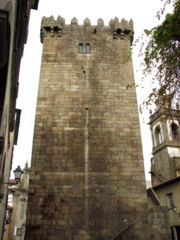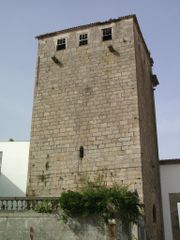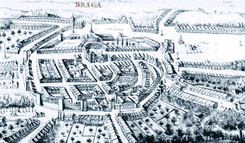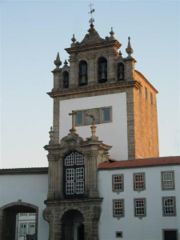
Braga Castle
Encyclopedia

Braga
Braga , a city in the Braga Municipality in northwestern Portugal, is the capital of the Braga District, the oldest archdiocese and the third major city of the country. Braga is the oldest Portuguese city and one of the oldest Christian cities in the World...
, freguesia
Freguesia
Freguesia is the Portuguese term for a secondary local administrative unit in Portugal and some of its former colonies, and a former secondary local administrative unit in Macau, roughly equivalent to an administrative parish. A freguesia is a subdivision of a concelho, the Portuguese synonym term...
of São João do Souto
São João do Souto
São João do Souto is a Portuguese parish, located in the municipality of Braga. It has a population of 932 inhabitants and a total area of 0.22 km²....
, District of Braga
Braga (district)
The district of Braga is a district in the northwest of Portugal. The district capital is the city of Braga, and it is bordered by the district of Viana do Castelo in the north, Vila Real in the east, and Porto in the south...
, in Portugal
Portugal
Portugal , officially the Portuguese Republic is a country situated in southwestern Europe on the Iberian Peninsula. Portugal is the westernmost country of Europe, and is bordered by the Atlantic Ocean to the West and South and by Spain to the North and East. The Atlantic archipelagos of the...
; only a small section of the original structure remains today.
Braga is a city with over 2,000 years of history, and as an important administrative centre (civil and religious), its defences have undergone various phases of construction.
Beginnings

Hellenistic civilization
Hellenistic civilization represents the zenith of Greek influence in the ancient world from 323 BCE to about 146 BCE...
astronomer and geographer Ptolemy
Ptolemy
Claudius Ptolemy , was a Roman citizen of Egypt who wrote in Greek. He was a mathematician, astronomer, geographer, astrologer, and poet of a single epigram in the Greek Anthology. He lived in Egypt under Roman rule, and is believed to have been born in the town of Ptolemais Hermiou in the...
, in the mid-2nd century, mentions in his work Geographia
Geographia (Ptolemy)
The Geography is Ptolemy's main work besides the Almagest...
that the city of Bracara Augusta (present-day Braga) had earlier been under Roman rule
Hispania
Another theory holds that the name derives from Ezpanna, the Basque word for "border" or "edge", thus meaning the farthest area or place. Isidore of Sevilla considered Hispania derived from Hispalis....
. Archeological research sponsored by Minho University has discovered a defensive wall with a polygonal plan, reinforced by small semi-circular turrets, which dates to the 3rd century.
During the Migration Period
Migration Period
The Migration Period, also called the Barbarian Invasions , was a period of intensified human migration in Europe that occurred from c. 400 to 800 CE. This period marked the transition from Late Antiquity to the Early Middle Ages...
, the Suebi
Suebi
The Suebi or Suevi were a group of Germanic peoples who were first mentioned by Julius Caesar in connection with Ariovistus' campaign, c...
chose Braga as the capital of their kingdom due to its importance and traditions. However, the city declined in prominence over the next centuries as the Visigoth
Visigoth
The Visigoths were one of two main branches of the Goths, the Ostrogoths being the other. These tribes were among the Germans who spread through the late Roman Empire during the Migration Period...
s conquered it, the Moors
Moors
The description Moors has referred to several historic and modern populations of the Maghreb region who are predominately of Berber and Arab descent. They came to conquer and rule the Iberian Peninsula for nearly 800 years. At that time they were Muslim, although earlier the people had followed...
sacked it and the Christian forces of the Kingdom of León
Kingdom of León
The Kingdom of León was an independent kingdom situated in the northwest region of the Iberian Peninsula. It was founded in AD 910 when the Christian princes of Asturias along the northern coast of the peninsula shifted their capital from Oviedo to the city of León...
took it.
Although reliable information about the evolution of Braga's defences during these turbulent times is lacking, it is known that, from the 11th century, a second wall was under construction, to the south and to the west, complementing the old Roman wall to the north. Furthermore, it is known that in 1145, Archbishop John of Braga promised the Knights Templar
Knights Templar
The Poor Fellow-Soldiers of Christ and of the Temple of Solomon , commonly known as the Knights Templar, the Order of the Temple or simply as Templars, were among the most famous of the Western Christian military orders...
an imposing house within the city walls.
The medieval castle
In the 13th century, a new phase of construction began with the abandonment of the northern part of the Roman wall and the growth of the city around Braga CathedralBraga Cathedral
The Cathedral of Braga is one of the most important monuments in the city of Braga, in Northern Portugal. Due to its long history and artistic significance it is also one of the most important buildings in the country.-History:...
. Little information exists about this period, only that, during the reign of King Dinis
Denis of Portugal
Dinis , called the Farmer King , was the sixth King of Portugal and the Algarve. The eldest son of Afonso III of Portugal by his second wife, Beatrice of Castile and grandson of king Alfonso X of Castile , Dinis succeeded his father in 1279.-Biography:As heir to the throne, Infante Dinis was...
(1279–1325), a new wall was begun, as was a keep
Keep
A keep is a type of fortified tower built within castles during the Middle Ages by European nobility. Scholars have debated the scope of the word keep, but usually consider it to refer to large towers in castles that were fortified residences, used as a refuge of last resort should the rest of the...
. Work progressed slowly and, during the reign of King Ferdinand
Ferdinand I of Portugal
Ferdinand I , sometimes referred to as the Handsome or rarely as the Inconstant , was the ninth King of Portugal and the Algarve, the second son of Peter I and his wife, Constance of Castile...
(1367–1383), the new wall proved ineffective, as it permitted troops from Castile
Kingdom of Castile
Kingdom of Castile was one of the medieval kingdoms of the Iberian Peninsula. It emerged as a political autonomous entity in the 9th century. It was called County of Castile and was held in vassalage from the Kingdom of León. Its name comes from the host of castles constructed in the region...
to invade the city in the 1370s. During the 1383–1385 Crisis
1383–1385 Crisis
The 1383–1385 Crisis was a period of civil war in Portuguese history that began with the death of King Ferdinand I of Portugal, who left no male heirs, and ended with the accession to the throne of King John I in 1385, in the wake of the Battle of Aljubarrota.In Portugal, this period is also known...
, Braga, like other cities in northern Portugal, remained loyal to Castile. However, when a new king was acclaimed by the Coimbra Cortes of 1385, the city opened its gates to him. King John I
John I of Portugal
John I KG , called the Good or of Happy Memory, more rarely and outside Portugal the Bastard, was the tenth King of Portugal and the Algarve and the first to use the title Lord of Ceuta...
(1385–1433) also paid attention to its defences, reinforcing its walls with new rectangular towers.

Since the 16th century
Starting in the 16th century, the castle's defensive functions fell into disuse, as can be seen by the number of buildings raised right along its outside walls.In 1906, Braga Castle was unceremoniously demolished, with only the keep (Torre de Menagem) remaining.
On 23 June 1910, a decree classified the keep and some sections of the medieval wall as a national monument.
Features

To the east, the keep is the main remaining portion of the castle raised during King Dinis' reign. Square and Gothic
Gothic architecture
Gothic architecture is a style of architecture that flourished during the high and late medieval period. It evolved from Romanesque architecture and was succeeded by Renaissance architecture....
, it is some 30 metres high, divided into three floors in the interior. At the top, there are parapets in each corner and a double window. The roof is ringed with battlements. King Dinis' coat of arms is carved inside the tower and on its western façade.

